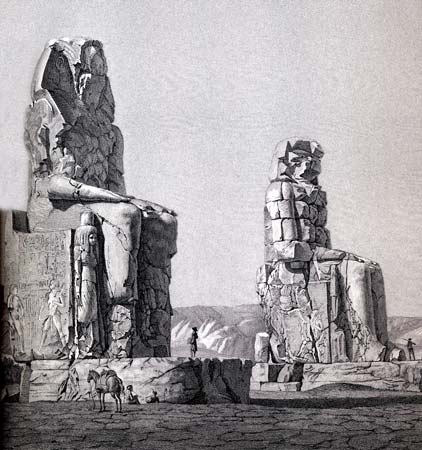
Amenhotep III (Nebmaatra, ruled 1390-1352 BC) was one of the most successful rulers of the New Kingdom and curiously there is very little of his mortuary temple remaining. This temple was actually 'robbed' in ancient times with it's blocks being used by other kings - by the time of Merenptah (Baenra, 1213-1203 BC), who styled his own mortuary temple from it, the majority of the temple had already been destroyed.
Recent excavations have revealed more of the temple, including two other Colossi. The remaining features include a strange Sphinx with a Lion's front and a crocodile abdomen. Stelae, statues and Colossi have been found but most of the original temple has either been removed for re-use or removed to museums. Many of the statues are in a classic style, but some are also in the later Armarna style - suggesting that Amenhotep IV (Akhenaten) was not the innovator of the temporary move from Amun to Aten.
The two seated figures representing Amenhotep III, but are usually styled "the Colossi of Memnon", are 65 ft high (40 cubits) and are carved from Quartzite. They are wearing the Nemes head-dress and originally had crowns. The weight of each statue is estimated at 800 tonnes. The inscriptions indicate that the rock was quarried from Gebel el Ahmar, although analysis indicates that Aswan is more likely. The statues are in a very poor condition and there is a possibility that they will not survive into the future without significant restoration.
Both are sitting on a thrown which is decorated with the symbols of a united Egypt; the two images of Hapy, the god of the Nile inundation, tying the plants of upper (lotus) and lower (papyrus) together. The south Colossi is better preserved and has figures of the King's mother Mutemwiya on the left and his wife, Queen Tiye, on the right. There is also a figure between the king's knees but it is not possible to determine who this represents.
The statues are a regular stop on the tourist route - by virtue of being on the road from Luxor to the Valleys of the Kings and Queens. However, this was also an ancient place of interest and there is various graffiti indicating Greek and Roman visitors. Emperor Septimius Severus (AD 193-211) had the statues repaired after they were damaged by an earthquake.
 Etching
of the statues created Napoleon's Savants and included in the
Description De L'Egypte.
Etching
of the statues created Napoleon's Savants and included in the
Description De L'Egypte.